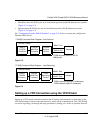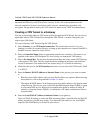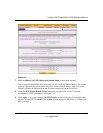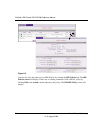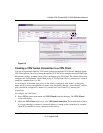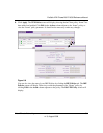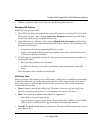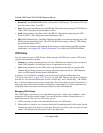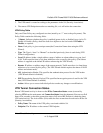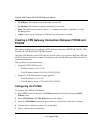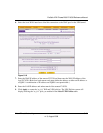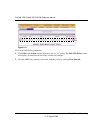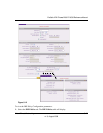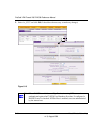
ProSafe VPN Firewall 200 FVX538 Reference Manual
Virtual Private Networking 5-11
v1.0, August 2006
• “Manual” generated VPN policies cannot use the IKE negotiation protocol.
Managing IKE Policies
IKE Policies are activated when:
1. The VPN Policy Selector determines that some traffic matches an existing VPN Policy. If the
VPN policy is of type “Auto”, then the Auto Policy Parameters defined in the VPN Policy
are accessed which specify which IKE Policy to use.
2. If the VPN Policy is a “Manual” policy, then the Manual Policy Parameters defined in the
VPN Policy are accessed and the first matching IKE Policy is used to start negotiations with
the remote VPN Gateway.
• If negotiations fail, the next matching IKE Policy is used.
• If none of the matching IKE Policies are acceptable to the remote VPN Gateway, then a
VPN tunnel cannot be established.
3. An IKE session is established, using the SA (Security Association) parameters specified in a
matching IKE Policy:
• Keys and other parameters are exchanged.
• An IPSec SA (Security Association) is established, using the parameters in the VPN
Policy.
The VPN tunnel is then available for data transfer.
IKE Policy Table
When you use the VPN Wizard to set up a VPN tunnel, an IKE Policy is established and populated
in the Policy Table and is given the same name as the new VPN connection name. You can also
edit exiting policies or add new IKE policies directly on the Policy Table Screen. Each policy
contains the following data:
• Name. Uniquely identifies each IKE policy. The name is chosen by you and used for the
purpose of managing your policies; it is not supplied to the remote VPN Server.
• Mode. Two modes are available: either “Main” or “Aggressive”.
– Main Mode is slower but more secure.
– Aggressive mode is faster but less secure. (If specifying either a FQDN or a User FQDN
name as the Local ID/Remote ID, aggressive mode is automatically selected.)
• Local ID. The IKE/ISAKMP identify of this device. (The remote VPN must have this value as
their “Remote ID”.)



